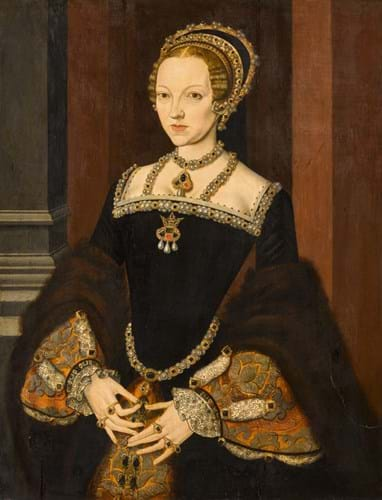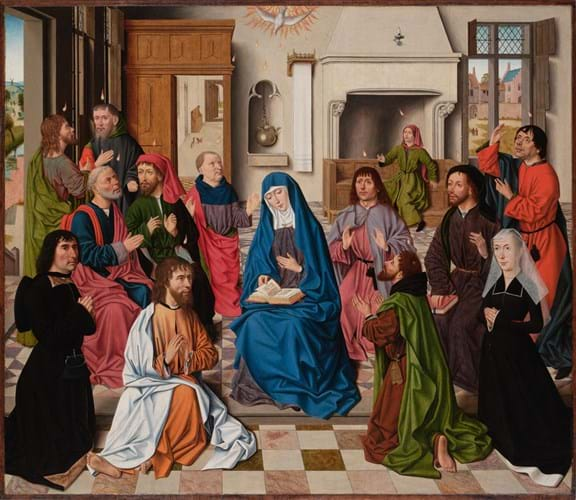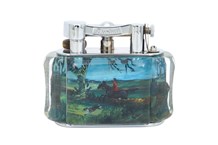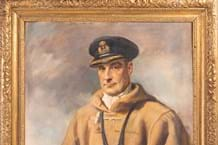
A portrait of Katherine Parr (1512-1548) attributed to the Tudor court artist known as ‘Master John’, £2.8m at Sotheby’s.
One of only two surviving contemporaneous paintings of Henry VIII’s sixth wife, the other being a full-length portrait now in the National Portrait Gallery, it came to auction from the collection of the Earl of Jersey.
Having been in the Earl’s family since at least 1861 and kept at their estates of Osterley Park, Middlesex, and Radier Manor, Jersey, it was erroneously recorded as ‘destroyed by fire’ in Roy Strong’s Tudor and Jacobean Portraits in 1969 (where the sitter was identified as Lady Jane Grey).
According to the Sotheby’s catalogue, it was most likely painted c.1547-8, shortly after Henry’s death. The NPG picture is from around two years earlier.
The catalogue states that the sitter can be securely identified from the distinctive crown topped jewel at her chest, which is recorded in detail in inventories of Katherine’s possessions. The brooch is thought to have been made for Katherine by her favourite goldsmith, the Dutch jeweller Peter Richardson.
As with the NPG portrait, the current work has been traditionally attributed to ‘Master John’, an unknown artist who was active in England in the 1540s. Having painted Mary I in 1544 (when she was a princess), his name is known from a mention in her expenses from that year: ‘Item, pd to one John that drue her grace in a table’.
Only a handful of works by his hand are known.
The 3ft 1in x 2ft 4in (92 x 72cm) oil on oak panel was estimated at £600,000-800,000 but, being a rare opportunity to acquire such a rarity and with its provenance traced back to the noted antiquary and collector John Dent (1761-1826), it brought determined bidding from a number of parties. It was eventually knocked down to a UK collector at £2.8m.
Also from the collection of the Earl of Jersey was another Tudor portrait by William Segar (fl.1580–1633) depicting Robert Devereux, 2nd Earl of Essex whose phenomenal rise as a favourite of Elizabeth I and fall after leading a treasonous rebellion has captivated generations of historians.
Estimated at £100,000-150,000, the portrait sold at £170,000.
The Sotheby’s sale as a whole raised £39m including premium but overall it was somewhat hard going with a number of lots selling either on or toward the lower end of their estimates.
While the selling rate of 65.3% (32 of the 49 lots sold) was on the low side for one these flagship London sales, the hammer total of £32.7m was below the sale’s presale estimate of £34.8m-49.4m.
The top lot was one of the works that sold on low estimate. The Pentecost scene by the artist known as ‘The Master of the Baroncelli Portraits’ (fl c.1490s) had previously appeared at Christie’s in 2010 where it made £4.19m including premium.
It came to auction here from a vendor who had acquired it from London dealer Jean-Luc Baroni. The fact that Sotheby’s arranged an ‘irrevocable bid’ from a third party in advance of the sale suggests strong competition to win the consignment and this was duly reflected in the punchy-looking £7m-10m estimate.
The £7m hammer price, although at the lower end of expectations, nevertheless represented an increase on its previous auction appearance and was a significant sum in terms of any Old Master sold at auction.
This was a reflection of its quality and rarity, with the catalogue pointing to ‘the finesse of the execution and the extraordinarily lifelike portrayal of the protagonists’. It was also the case that no other work by the illusive Netherlandish artist who was active in Bruges (even whose name remains unknown) has ever been emerged on the market. Indeed, only three other paintings are attributed to the artist, including a pair of portraits in the Uffizi, Florence.
Christie's Old Master Part I sale takes place later today (July 6).






